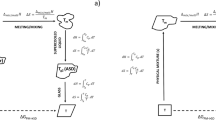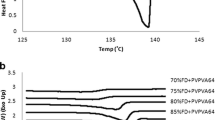ABSTRACT
Purpose
To quantitatively assess the solubility advantage of amorphous forms of nine insoluble drugs with a wide range of physico-chemical properties utilizing a previously reported thermodynamic approach.
Methods
Thermal properties of amorphous and crystalline forms of drugs were measured using modulated differential calorimetry. Equilibrium moisture sorption uptake by amorphous drugs was measured by a gravimetric moisture sorption analyzer, and ionization constants were determined from the pH-solubility profiles. Solubilities of crystalline and amorphous forms of drugs were measured in de-ionized water at 25°C. Polarized microscopy was used to provide qualitative information about the crystallization of amorphous drug in solution during solubility measurement.
Result
For three out the nine compounds, the estimated solubility based on thermodynamic considerations was within two-fold of the experimental measurement. For one compound, estimated solubility enhancement was lower than experimental value, likely due to extensive ionization in solution and hence its sensitivity to error in pKa measurement. For the remaining five compounds, estimated solubility was about 4- to 53-fold higher than experimental results. In all cases where the theoretical solubility estimates were significantly higher, it was observed that the amorphous drug crystallized rapidly during the experimental determination of solubility, thus preventing an accurate experimental assessment of solubility advantage.
Conclusion
It has been demonstrated that the theoretical approach does provide an accurate estimate of the maximum solubility enhancement by an amorphous drug relative to its crystalline form for structurally diverse insoluble drugs when recrystallization during dissolution is minimal.




Similar content being viewed by others
Notes
The term solubility, when used in the context of an amorphous form, does not necessarily refer to the thermodynamic solubility and should be interpreted as an “apparent solubility,” which may be significantly lower than the true thermodynamic value.
REFERENCES
Murdande SB, Pikal MJ, Shanker RM, Bogner RH. Solubility advantage of amorphous pharmaceuticals: I. A thermodynamic analysis. J Pharm Sci. 2010;99:1254–64.
Hancock BC, Zografi G. Characteristics and significance of the amorphous state in pharmaceutical systems. J Pharm Sci. 1997;86:1–12.
Yu L. Amorphous pharmaceutical solids: preparation, characterization and stabilization. Adv Drug Deliv Rev. 2001;48:27–42.
Craig DQ, Royall PG, Kett VL, Hopton ML. The relevance of the amorphous state to pharmaceutical dosage forms: glassy drugs and freeze dried systems. Int J Pharm. 1999;179:179–207.
Kaushal AM, Gupta P, Bansal AK. Amorphous drug delivery systems: molecular aspects, design and performance. Crit Rev Ther Drug Carr Syst. 2004;21:133–93.
Li DX, Oh Y-K, Lim S-J, Kim JO, Yang HJ, Sung JH, et al. Novel gelatin microcapsule with bioavailability enhancement of ibuprofen using spray-drying technique. Int J Pharm. 2008;355:277–84.
Kim J-S, Kim M-S, Park HJ, Jin S-J, Lee S, Hwang S-J. Physicochemical properties and oral bioavailability of amorphous atorvastatin hemi-calcium using spray-drying and SAS process. Int J Pharm. 2008;359:211–9.
Vasconcelos T, Sarmento B, Costa P. Solid dispersions as strategy to improve oral bioavailability of poor water soluble drugs. Drug Discov Today. 2007;12:1068–75.
Hancock BC, Parks M. What is the true solubility advantage for amorphous pharmaceuticals? Pharm Res. 2000;17:397–404.
Chawla G, Gupta P, Thilagavathi R, Chakraborti AK, Bansal AK. Characterization of solid-state forms of celecoxib. Eur J Pharm Sci. 2003;20:305–17.
Bansal SS, Kaushal AM, Bansal AK. Molecular and thermodynamic aspects of solubility advantage from solid dispersions. Mol Pharmaceutics. 2007;4:794–802.
Ran Y, Neera J, Yalkowsky SH. Solubility and partitioning of aqueous solubility of organic compounds by the General Solubility Equation (GSE). J Chem Inf Comput Sci. 1980;41:1208–17.
Yalkowski SH, Valvani SC. Solubility and partitioning I: solubility of nonelectrolytes in water. J Pharm Sci. 1980;69:912–22.
Neera J, Yalkowsky SH. Estimation of the aqueous solubility I: application to organic nonelectrolytes. J Pharm Sci. 2001;90:234–52.
Yalkowsky SH. Estimation of the aqueous solubility of complex organic compounds. Chemosphere. 1993;26:1239–61.
Yalkowsky SH. Solubility and partitioning V: dependence of solubility on melting point. J Pharm Sci. 1981;70:971–3.
Amidon GL, Williams NA. A solubility equation for non-electrolytes in water. Int J Pharm. 1982;11:249–56.
http://www.who.int/medicines/publications/essentialmedicines/en/. WHO Model List. Essential Medicines.. http://www.who.int/medicines/publications/essentialmedicines/en/.
Lipinski CA, Lombardo F, Dominy BW, Feeney PJ. Experimental and computational approaches to estimate solubility and permeability in drug discovery and development settings. Adv Drug Deliv Rev. 1997;23:3–25.
Lipinski CA, Lombardo F, Dominy BW, Feeney PJ. Experimental and computational approaches to estimate solubility and permeability in drug discovery and development settings. Adv Drug Deliv Rev. 2001;46:3–26.
Manderschid M, Eichinger T. Determination of pKa values by liquid chromatography. J Chromatogr Sci. 2003;41:323–6.
Murdande SB, Pikal M, Shanker R, Bogner R. Aqueous solubility of crystalline and amorphous drugs: challenges in measurement. Pharm Dev Technol. (2010). doi:10.3109/10837451003774377.
Johari GP, Shanker RM. Calorimetric relaxation and the glass-liquid temperature range of acetaminophen-nifedipine alloys. J Pharm Sci. 2007;9999:n/a .
Tombari E, Presto S, Johari G, Shanker R. Molecular mobility, thermodynamics and stability of Griseofulvin’s ultraviscous and glassy states from dynamic heat capacity. Pharm Res. 2008;25:902–12.
Wan H, Holmen AG, Wang Y, Lindberg W, Englund M, Nagard MB, et al. High-throughput screening of pKa values of pharmaceuticals by pressure-assisted capillary electrophoresis and mass spectrometry. Rapid Commun Mass Spectrom. 2003;17:2639–48.
Gerakis AM, Koupparis MA, Efstathiou CE. Micellar acid–base potentiometric titrations of weak acidic and/or insoluble drugs. J Pharm Biomed Anal. 1993;11:33–41.
Chiang P-C, Foster KA, Whittle MC, Su C-C, Pretzer DK. Medium throughput pKa determinations of drugs and chemicals by reverse phase HPLC with an organic gradient. J Liq Chromatogr Relat Technol. 2006;29:2291–301.
Wiczling P, Kawczak P, Nasal A, Kaliszan R. Simultaneous determination of pKa and lipophilicity by gradient RP HPLC. Anal Chem. 2006;78:239–49.
Zhou D, Zhang GGZ, Law D, Grant DJW, Schmitt EA. Thermodynamics, molecular mobility and crystallization kinetics of amorphous griseofulvin. Mol Pharm. 2008;5:927–36.
Greco K, Bogner RH. Crystallization of amorphous indomethacin during dissolution: Effect of processing and annealing. Mol Pharm (2010). doi:10.1021/mp1000197.
Zhou D, Zhang GGZ, Law D, Grant DJW, Schmitt EA. Physical stability of amorphous pharmaceuticals: Importance of configurational thermodynamic quantities and molecular mobility. J Pharm Sci. 2002;91:1863–72.
Author information
Authors and Affiliations
Corresponding author
Rights and permissions
About this article
Cite this article
Murdande, S.B., Pikal, M.J., Shanker, R.M. et al. Solubility Advantage of Amorphous Pharmaceuticals: II. Application of Quantitative Thermodynamic Relationships for Prediction of Solubility Enhancement in Structurally Diverse Insoluble Pharmaceuticals. Pharm Res 27, 2704–2714 (2010). https://doi.org/10.1007/s11095-010-0269-5
Received:
Accepted:
Published:
Issue Date:
DOI: https://doi.org/10.1007/s11095-010-0269-5




